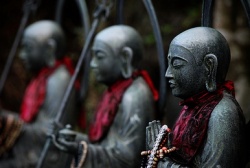The Qualities and Virtues of the Buddha
By Mithra Wettimuny
In order to recall the qualities and virtues of the Buddha we use the following stanza which is well known.
"iti pi so bhagava araham sammasambuddho
vijjacharana sampanno sugato lokavidu anuttaro
purisa dhamma sarati satta deva manussanam
buddho bhagava ti".
I) The quality of araham means that he has completely destroyed all greed, aversion and ignorance. The Buddha is one who has realised the four noble truths, nibbana and has come to the end of all suffering. The quality of arahantship is not exclusive to a sammasambuddha. It is also common to the Silent Buddha and all Arahants.
II) However, the quality of sammasambuddha ,is exclusive to a sammasambuddha. The sammasambuddha is one who acquires the knowledge of the four noble truths without the assistance of anyone else, thereafter teaches others to realise the four noble truths.
(III) 'Vijja charana sam panno' 'Vijja' means science or knowledge. 'charana' means conduct. 'Sampanno' means endowed with. So it means endowed with knowledge and conduct. Under this word vijja we can consider some knowledges he was endowed with, which are not exclusive to him.
IV) The quality of sugatha means beauty excellent, pleasant. And what is it that is beautiful, excellent and pleasing, it is this noble eightfold path. Each and every step of this noble eightfold path, is beautiful, pleasant, excellent. He was also endowed with a beautiful body which radiated a multi coloured aura.
V) Lokavidu means the seer of the world. He sees everything as it really is, with regard to this world. He sees all the conditions that bring about a situation, that bring about a dhamma, the root causes, the proximate causes, and the results that can come, that can flow from that situation. All that is his knowledge or his ability to see the world as it really is.
VI) 'Anutharo Purisa Dhamma Sarati' means he was an incomparable tamer of the tameable.
(VII) 'Satta deva manussanam' means, he is the teacher to gods and humans. The word deva refers to both the gods and brahmas. And in that field he was incomparable. He was the supreme teacher and a vast number of gods, brahmas and human beings received his teachings, his advice, his guidance and they liberated themselves from this mass of suffering as a result of that. That is his teaching quality.
(VIII) 'Bhuddho' means the one who has fully realised the four noble truths, fully realised nibbana by one's own effort without any assistance from another. That is a quality common not only to a Sammasambuddha, but also to those who are called the silent buddhas. The difference between a Sammasambuddha and a Silent Buddha is that the Silent Buddhas do not teach.
(IX) And finally his quality of 'bhagava' means he stands exalted. He is exalted beyond comparison. He is exalted because of his immeasurable merits, because of his ten perfections. No other being's perfections can be compared with that of a Sammasambuddha, As a result of the perfection of dana or gifting, millions of folks pay homage to him, make offerings, even after 2500 years. That is the result of his quality called bhagava.
So we know these nine qualities in him. Accordingly, we pay homage to him. Recalling the qualities and virtues of the Buddha also serves to express our gratitude to Buddha.
Recollection of the qualities and virtues of the Buddha is also a valuable Meditation to develop the faculty of faith. You may develop the noble eightfold path using this particular meditation as a preliminary meditation, because it is a meditation that enables you to overcome obstacles. Obstacles can arise from the external and from the internal.
This path is made a very pleasant and powerful one through this meditation. Use it whilst developing insight by the practice of the four foundations of mindfulness that will lead you to knowledge and wisdom, realise the four noble truths realise the four fruits of the path and nibbana.
